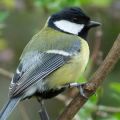
More social birds are more adventurous feeders, study finds
A new study led by researchers at the University of Oxford has found that birds that are more social are more likely to use novel sources of food. The findings have been published in iScience.
The findings suggest that highly social birds may alleviate the costs of competition for food by foraging more broadly and exploiting novel food sources, but future research could explore whether there are additional reasons which explain why more social individuals are more likely to tolerate new foods.
Senior researcher Dr Josh Firth, Department of Biology, University of Oxford
In nature, feeding in groups has various advantages – such as for spotting predators and finding the best places to eat – but hanging around with others also comes with the drawback of increased competition for food resources. One way that sociable individuals could reduce competition is by broadening their diets to include new types of food. For the first time, researchers have now demonstrated a direct link between individual birds’ position within their ‘social network’ and their likelihood to exploit novel food sources.
The study, carried out in Wytham Woods, Oxfordshire, assessed the behaviour of 105 wild great tits while they foraged in flocks during the winter. By fitting the birds with radio frequency identification (RFID) tags, the researchers were able to precisely monitor each individual’s behaviour at feeders as well as tracking each bird’s ‘social network position’ in relation to how many social associates they held and who they preferred to spend time with.
After closely monitoring the birds to establish their social network, the researchers then tested each birds’ propensity to use novel foods. At one of the feeding stations, the birds were offered a choice between a feeder containing a familiar food (ground peanuts) and one containing a novel looking food (ground peanuts dyed red or green). Over 19 days, the researchers tracked how often the birds used the new food source over the familiar food, then analysed whether this was linked to a range of different factors.
 A RFID-tagged great tit at one of the feeders in Wytham Woods. Image credit: Sam Crofts.
A RFID-tagged great tit at one of the feeders in Wytham Woods. Image credit: Sam Crofts.Curiously, sociability had no impact on how quickly birds first used the novel feeder, with most birds (92%) using the novel food at some point during the trial, and no difference between sociable birds and less sociable birds in how quickly they tried it.
Lead researcher Dr Keith McMahon (Department of Biology, University of Oxford) said: ‘This indicates that the increased usage of the novel food by the more social birds was not due to them being generally more exploratory or brave, but rather that more social birds are more likely to use novel food as a way of expanding their diets to offset the costs of having more foraging associates.’
The researchers suggest that future work could examine how more social individuals may receive additional information about new food sources transmitted through their group members, increasing their confidence in using these novel options.
The study ‘Social network centrality predicts dietary decisions in a wild bird population’ has been published in iScience.
 Nature degradation could cause a 12% loss to UK GDP
Nature degradation could cause a 12% loss to UK GDP
 Landmark study definitively shows that conservation actions are effective at halting and reversing biodiversity loss
Landmark study definitively shows that conservation actions are effective at halting and reversing biodiversity loss
 Researchers find oldest undisputed evidence of Earth’s magnetic field
Researchers find oldest undisputed evidence of Earth’s magnetic field
 Honorary degree recipients for 2024 announced
Honorary degree recipients for 2024 announced
 Vice-Chancellor's innovative cross-curricular programme celebrated
Vice-Chancellor's innovative cross-curricular programme celebrated
 Bold male birds fall faster and harder for their partners
Bold male birds fall faster and harder for their partners
 Birds choose their neighbours based on personality
Birds choose their neighbours based on personality
 Birds conform to local 'traditions'
Birds conform to local 'traditions'